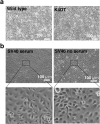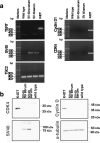The transcriptome of wild-type and immortalized corneal epithelial cells
- PMID: 33963195
- PMCID: PMC8105388
- DOI: 10.1038/s41597-021-00908-9
The transcriptome of wild-type and immortalized corneal epithelial cells
Abstract
Cellular immortalization enables indefinite expansion of cultured cells. However, the process of cell immortalization sometimes changes the original nature of primary cells. In this study, we performed expression profiling of poly A-tailed RNA from primary and immortalized corneal epithelial cells expressing Simian virus 40 large T antigen (SV40) or the combination of mutant cyclin-dependent kinase 4 (CDK4), cyclin D1, and telomere reverse transcriptase (TERT). Furthermore, we studied the expression profile of SV40 cells cultured in medium with or without serum. The profiling of whole expression pattern revealed that immortalized corneal epithelial cells with SV40 showed a distinct expression pattern from wild-type cells regardless of the presence or absence of serum, while corneal epithelial cells with combinatorial expression showed an expression pattern relatively closer to that of wild-type cells.
Conflict of interest statement
The authors declare no competing interests.
Figures







References
MeSH terms
Substances
LinkOut - more resources
Full Text Sources
Other Literature Sources
Research Materials

